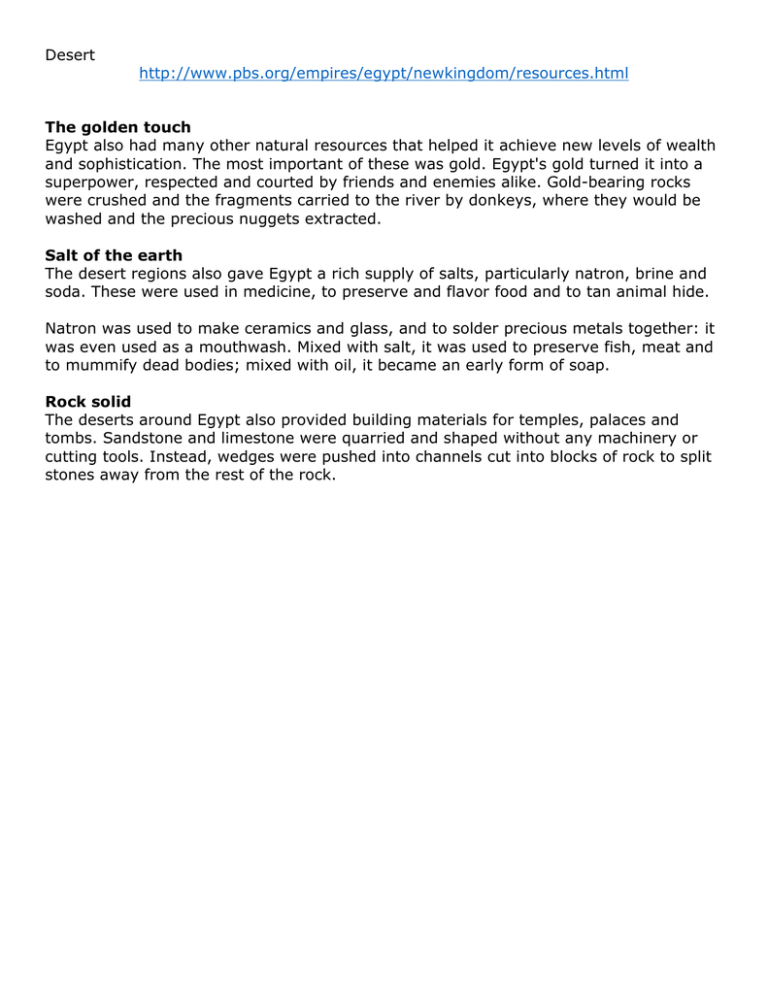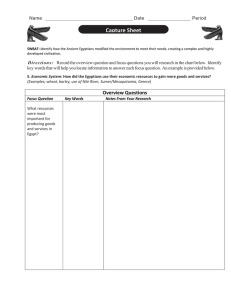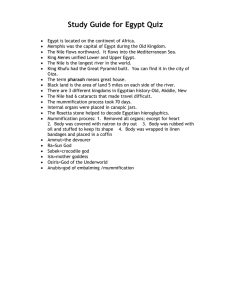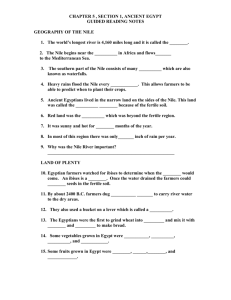Desert http://www.pbs.org/empires/egypt/newkingdom/resources
advertisement

Desert http://www.pbs.org/empires/egypt/newkingdom/resources.html The golden touch Egypt also had many other natural resources that helped it achieve new levels of wealth and sophistication. The most important of these was gold. Egypt's gold turned it into a superpower, respected and courted by friends and enemies alike. Gold-bearing rocks were crushed and the fragments carried to the river by donkeys, where they would be washed and the precious nuggets extracted. Salt of the earth The desert regions also gave Egypt a rich supply of salts, particularly natron, brine and soda. These were used in medicine, to preserve and flavor food and to tan animal hide. Natron was used to make ceramics and glass, and to solder precious metals together: it was even used as a mouthwash. Mixed with salt, it was used to preserve fish, meat and to mummify dead bodies; mixed with oil, it became an early form of soap. Rock solid The deserts around Egypt also provided building materials for temples, palaces and tombs. Sandstone and limestone were quarried and shaped without any machinery or cutting tools. Instead, wedges were pushed into channels cut into blocks of rock to split stones away from the rest of the rock. Rivers http://www.pbs.org/empires/egypt/newkingdom/farming.html Living on fertile ground Fortunately for the pharaohs, ancient Egypt was located on the banks of the Nile, the longest river in the world. From June to October each year, the Nile flooded the surrounding countryside, before receding again over the winter. Every time the Nile waters ebbed away, they left rich silt on the previously flooded plains. This made the soil along the Nile extremely fertile, enabling the farmers to enjoy good harvests year in, year out. They planted their crops every February, after the Nile had receded back to the river bed, and harvested them each June, shortly before the floods came. Bread and beer The fertile soil meant that Egypt's farmers could grow a huge variety of crops. The most basic of these were emmer wheat and barley. These were used to make bread, the staple of the Egyptian diet, as well as cakes and beer, which were often flavored with spices, honey or dates. The bread was often supplemented by lentils, garlic, peas and fava beans. Fruit and veg Egyptians also ate a wide variety of vegetables and fruit. Lettuces, cucumbers, leeks, onions and radishes could all be grown in the fertile floodplains. There were also plenty of orchards, in which pomegranates, dates, melons and figs were grown. Many estates by the Nile had vineyards (the Egyptians liked their wine), while the floodplains also provided fertile ground for flax and the castor-oil plant, both of which contained oils used for cooking and medicine. Lunch that walks Although meat and poultry were too expensive for most Egyptians to eat everyday, they were a common sight in the countryside. Ducks and geese lived along the banks of the Nile, and farmers would keep sheep, goats, cattle and pigs, as well as donkeys, the basic working animal in ancient Egypt. Of course, the Nile itself was a fantastic source of fresh fish, including perch, catfish and tilapia. What's more, during the summer flood, huge numbers of water birds would flock to the Nile. These were often trapped or snared to provide a little seasonal variety on the dinner table. Ancient flood technology The Egyptians made the most of the flood season in other ways too. They built embankments and dykes along the Nile to control the flow of water, so that the flooding would give maximum benefit to the farming areas without threatening nearby buildings and villages. The dykes helped Egyptian farmers to take advantage of natural depressions in the floodplain, called flood basins. Water was allowed to flow downhill from one basin to another, and artificial channels were built to take water to far-flung areas if the floodwater was low in any given year. The post is here During the New Kingdom, farmers invented a new way of lifting floodwater, known as shaduf. A cross-pole was attached to a post in the ground: one end had a container attached; the other had a counter-weight. The container was filled with water from a channel before being raised up by the counterweight and swung to where the farmer wanted the water to go. Although this may not seem much today, over 3,000 years ago it was the height of farming technology. The shaduf helped Egyptian farmers to spread the water around, fertilizing dry areas and so extracting the maximum benefit from seasonal flooding, keeping Egypt fed and fit for action. Reed all about it Egyptians had a winning way with reeds, which grew in huge numbers beside the Nile. Reeds were the material with a million uses: they were turned into mats, baskets and sandals, while the mud they grew in was used as clay for pottery and bricks. They also had a massive supply of papyrus, a plant that grew in marshes and swamps near the Nile. Papyrus was used to make paper. The stalks were sliced into strips: these were then laid over each other and beaten to make a sheet. Because it could quickly be written on with pen and ink, and easily rolled up and carried, papyrus soon became indispensable. Bureaucrats could now ensure that a famine could be averted and its soldiers properly supplied. Lessons could be learned and knowledge could be stored, bringing Egypt to new levels of efficiency. While its power was based primarily on gold, it was papyrus that gave Egypt its sophistication.




